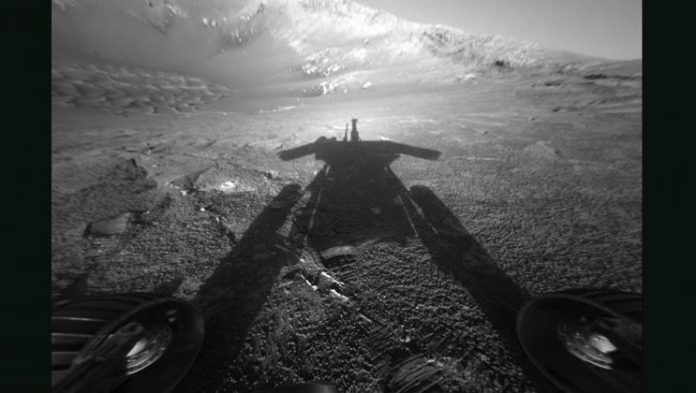
Feb. 13 (UPI) — Opportunity’s 15-year scientific mission is officially done, and so is the Martian rover. Scientists at NASA’s Jet Propulsion Laboratory declared the spacecraft dead after their latest attempt to revive the rover failed.
Opportunity last communicated with mission scientists on June 10. Shortly afterwards, a planet-wide dust storm enveloped Perseverance Valley, stranding the rover.
Perseverance Valley is a fitting final resting spot for the spacecraft, which was originally expected to conduct science for just 90 days. Engineers estimated the rover’s maximum range at 1,100 yards. Opportunity lasted 15 years and logged 28 miles.
“For more than a decade, Opportunity has been an icon in the field of planetary exploration, teaching us about Mars’ ancient past as a wet, potentially habitable planet, and revealing uncharted Martian landscapes,” Thomas Zurbuchen, associate administrator for NASA’s Science Mission Directorate, said in a news release.
“Whatever loss we feel now must be tempered with the knowledge that the legacy of Opportunity continues — both on the surface of Mars with the Curiosity rover and InSight lander — and in the clean rooms of JPL, where the upcoming Mars 2020 rover is taking shape.”
For the last several months, scientists have regularly attempted to contact and revive the rover, but the failures suggest Opportunity’s batteries are totally drained. Without sunlight, the rover was unable to recharge. Without battery power, the rover was unable to keep its heaters running to protect its components from frigid temperatures during the night.
From the beginning, Opportunity exceeded expectations and set records. The rover ends its mission with several unmatched feats. In 2005, for example, Opportunity set the single day Martian driving record, traversing 721 feet in less than 24 hours.
Of course, the rover’s mission wasn’t about setting speed records. It went to Mars to study the Red Planet’s geology. During its 15-year mission, the rover cleared dust from 52 rocks, exposing the mineral surfaces for analysis. Opportunity cleared dozens more rock’s surfaces for measurements using its spectrometers and a microscopic imager.
The rover’s observations helped scientists build the case that Mars once hosted significant amounts of liquid water. Opportunity documented both the chemical and geological signatures of water and water-caused erosion.
“From the get-go, Opportunity delivered on our search for evidence regarding water,” said Steve Squyres, Cornell University researcher and principal investigator for the rover’s science payload. “And when you combine the discoveries of Opportunity and Spirit, they showed us that ancient Mars was a very different place from Mars today, which is a cold, dry, desolate world. But if you look to its ancient past, you find compelling evidence for liquid water below the surface and liquid water at the surface.”
Though Opportunity will be missed, NASA scientists still have plenty of robotic boots on the Martian ground. The Curiosity and Spirit rovers will continue to collect geological data. And last year, NASA added another lander to the mix.
The InSight lander touched down in November and has since deployed its seismometer — the first seismometer to be placed directly on the surface of Mars. For two years, InSight will stay perfectly still while the domed instrument listens to the seismic waves traveling through Mars.
The patterns of seismic waves measured by InSight will reveal details about Mars’ insides. Scientists hope these patterns will help them better understand Mars’ inner structures and composition, as well as offer insights into the Red Planet’s origins and evolution.





